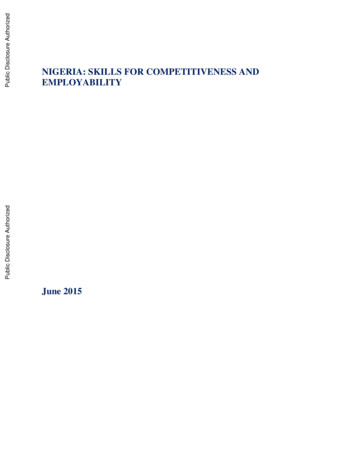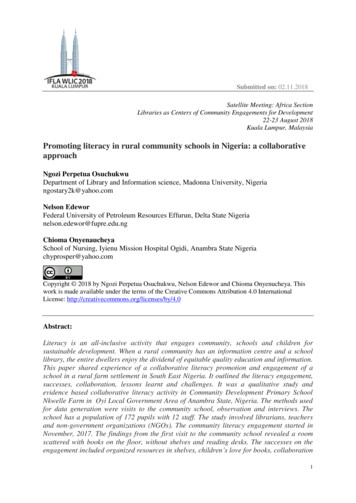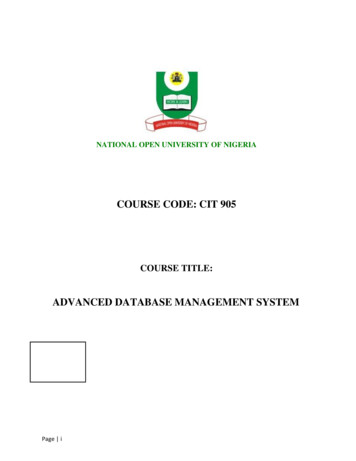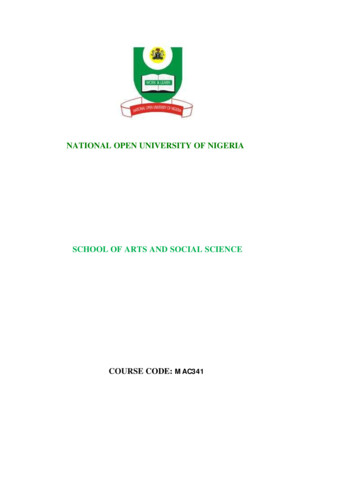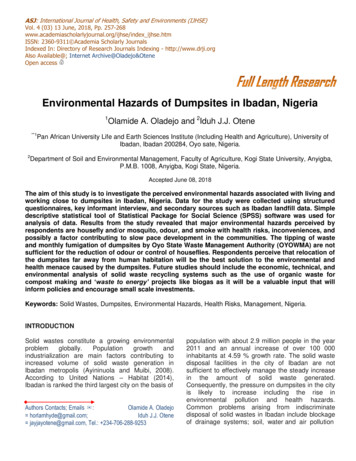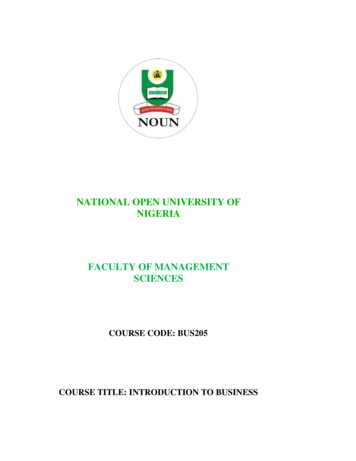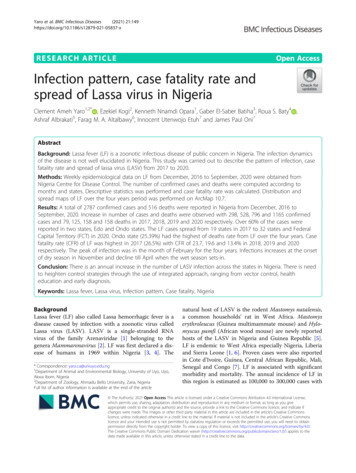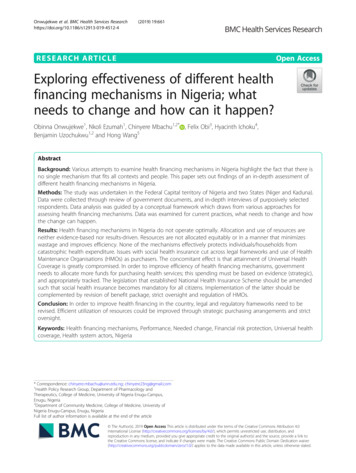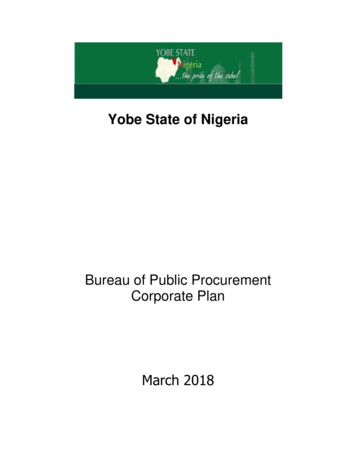
Transcription
Yobe State of NigeriaBureau of Public ProcurementCorporate PlanMarch 2018
AcknowledgementThe importance and the quest for the development of a strategic Corporate Plan for a youngestablishment like ours that will be in tandem with International best practices cannot be overemphasized. The enthusiasm of our stakeholders and the collaboration with our developmentpartners to come up with this beautiful plan, gives us the confidence to build on the successes sofar achieved.In the same vein valuable contributions were made by individuals and Corporate organizationsfrom both the public and private sectors towards the success of this strategic plan document.We wish to express our huge gratitude to His Excellency, Alhaji (Dr.) Ibrahim Gaidam, FCNA,FCPA, the Executive Governor of Yobe State for his immense commitment, strong political willand support to this exercise. Similarly, we commend the contributions of the Council Chairmanwho is equally the Honourable Commissioner of Finance, Alhaji Mohammed Ismaila Nguru for hisguidance towards the attainment of this plan.We are also grateful to the Council Members of the Bureau for their support in developing thisdocument. We are indeed indebted to them all.Our deep appreciation also goes to the Secretary to the State Government, Alhaji Baba MallamWali mni, for his continuous support, zeal and commitment towards the implementation of theProcurement Law. We equally acknowledge the efforts of the Head of Service, Mallam SalehAbubakar and indeed the PSM Advisory Committee and Core Group members for theircontributions towards successful formulation of the Corporate Plan. We remain grateful to thecontributions of Accountable, Responsive and Capable Government (ARC) for providingtechnical, logistic and financial support in the course of developing this document.I want to recognize the commitment and understanding of my colleagues, the Bureau Staff. Theirimmense contributions towards the success of this exercise can only be rewarded by the AlmightyAllah (SWT).Lastly, we remain grateful to the Almighty Allah (SWT) for the guidance and protection tosuccessfully complete the assignment. May HE continue to guide us. Amin.ISMAILA MAI-ADAMUDIRECTOR GENERALBUREAU ON PUBLIC PROCUREMENT2
Content ListAbbreviations and AcronymsExecutive SummaryAcknowledgement . 2Abbreviations and Acronyms . 51.0Section One: Introduction . 61.1Objectives and tasks . 71.2Approach . 71.3Report . 81.4Summary . 82.0Section Two: The Corporate Planning Framework . 93.0Section Three: Mandates . 114.0Section Four: Vision, Mission and Core Value statements . 145.0Section Five: PESTLE/SWOT Factors . 156.0Section Six: Long-Term Goals, Medium-Term Objectives and Strategies . 17Table 6.1 BPP’s LGTs, MTOs and Strategies . 187.0Section Seven: Functional, Process and Systems Reviews . 20Functional Review . 20Table 7.1: Existing Functions of BPP Technical Departments . 20Table 7.2 Proposed Functions of Policy and Standard Department . 21Table 7. 3: Proposed Functions of Procurement Compliance Department . 21Table 7.4: Proposed Functions of Planning, Research and Documentation Department . 24Process Review . 25Policy and Standards Department . 25Procurement Compliance Department . 28Planning, Research and Documentation Department . 31Management Systems: . 328.0Section Eight: Structural review . 34Diagram 3: Proposed Organisational Structure for the Bureau of Public Procurement . 34Diagram 4: Proposed Policy and Standards Department . 35Diagram 5: Proposed Procurement Compliance Department . 36Diagram 6: Proposed Research and Documentation Department . 37Diagram 7: Proposed Finance, Administration and Human Resources ManagementDepartment . 38Appendix 1: Members of the PSM Advisory Group . 39List of PSM Core Group . 393
Appendix 2: Terms of Reference for PSM Advisory Committee . 40Appendix 3:Terms of Reference for the PSM Core Group . 42Appendix 4: List of PSM Technical Working Group . 444
Abbreviations and AcronymsBPPBureau on Public ProcurementSMARTSpecific, Measurable, Achievable, Reliable and TimeboundLTGLong Term GoalsMTOsMedium Term ObjectivesSIPSector Implementation PlanHRHuman ResourceICTInformation, Communication and TechnologyCoPCommunity of PracticeHRMHuman Resource ManagementCGCore GroupCPCorporate PlanningDGDirector GeneralHoDHead of DepartmentLGALocal Government AreaMDAsMinistries, Departments and ublic Service ManagementSHoAState House of AssemblySWOTStrengths, Weaknesses, Opportunities and ThreatsTWGTechnical Working GroupYOSERAYobe Socio-economic Reform AgendaSocial,5Technological,Legaland
1.0 Section One: IntroductionYobe State was created out of the old Borno State by the military regime of General IbrahimBadamasi Babangida on August 27, 1991. It has its capital at Damaturu. As indicated on the map,the state has 17 local governmentareas. It is located within latitude 11North and longitude 13.5 East with atotal land area of 47,153 squarekilometers.Itsharescommonboundaries with Borno State to theEast and South–east, Jigawa State tothe Northwest, Bauchi and Gombestates to the South-west. It also sharesan international border with theRepublic of Niger. This boundarystretches over 323km to the north ofthe State. According to the 2006National Population census, the Statehad a population figure of about2,321,591 million made up of1,206,003 males and 1,115,588females. However, given its highpopulation growth rate estimated atabout 3.2% per annum, the populationis expected to rise to about 3.4 millionin 2018.Yobe State’s economy is relatively small with a per capita income estimated to be aboutUS 222.99 compared to the national average put at US 887.63. Yobe’s economy contributesabout 0.42% to the national Gross Domestic Product. Yobe State has been grappling with thefundamental development challenges of raising the standard of living of the people throughaccountable governance. Various administrations have tried to overcome severe resourceconstraints to improve human development indices in the State as well as its economy andsecurity. The State has a State Development Plan known as the Yobe State Socio-economicReform Agenda (YOSERA), which is in its fourth generation to ensure open and accountablegovernment for the delivery of improved goods and services to the people. To strengthen thisinitiative, in 2016, the Yobe State House of Assembly enacted a law known as the Yobe StateBureau on Public Procurement Law, 2016 (the Law) which established the Yobe State Bureau onPublic Procurement (the Bureau). It was established as the oversight/regulatory body to supportthe development and implementation of the public procurement regulatory system for the State.The Bureau’s responsibilities and powers are provided under sections 4 and 5 of the Law, inaddition to responsibilities provided in other sections. The Bureau is a legal entity, which reportsto a Council also established by the same Law.6
1.1Objectives and tasksThe primary objective of the Technical Working Group1 (TWG) in Yobe State is to review andimprove the organization, institutions and human resources capacities and capabilities of theBureau to ensure effective and efficient public procurement of goods and services for the Stategovernment. This would be achieved through the development and implementation of a CorporatePlan (CP). The TWG reviewed documents prior to the activities that led to the development of theCP, and carried out the following activities during training sessions where the relevant stages ofthe CP were developed: Reviewed and revised the core mandates, functions, objectives and responsibilities of theBureau as outlined in the Law. Reviewed and revised the Vision, Mission and Core-Values statements of the Bureaudeveloped by management of the Bureau and reviewed by the TWG.1.2ApproachThe approach deployed was participatory with all members of the TWG fully engaged in theprocess. The following steps supported by consultants were undertaken starting with thepreparation protocols: Political commitment to CP process, which included: support for the process,implementing the recommendations and provision of time and other resources when andwhere required, and for monitoring the implementation. Establishing the CP Governancestructure, which includes:othe PSM Advisory Committee2 is chaired by the Head of Service. Its responsibilitiesinclude driving, overseeing the CP processes, approving the outputs and ensuringimplementation and monitoring.othe PSM Core Group (PSM CG)3 is chaired by the Permanent Secretary, Ministryof Education. Its responsibilities include overseeing and managing the activities ofthe TWG) which was specifically established to undertake the technical sessionsof the CP. The PSM CG briefs, and where necessary obtains approvals from thePSM Advisory Committee.othe Technical Working Group (TWG)4: Consists of both PSM Advisory Committeeand PSM CG. Its responsibilities include undertaking technical sessions on variousaspects of CP, running, and participating in all the events, preparing outputs forthe various CP stages, regularly briefing, and submitting outputs to the PSM CG. Desk review of all existing materials including the Law establishing the Bureau. Developedpresentation slides, case examples, and templates used during training workshops. Facilitated workshops on CP where groups were formed to discuss details.1Technical Working Group consists of members of the PSM Advisory Committee and the PSM Core GroupAppendix 2: Members of the PSM Advisory Committee and the Terms of Reference3Appendix 3: Members of PSM Core Group and Terms of Reference24Appendix 4: Members of CP Technical Working Group7
Performed institutional and context appraisal, which involved measuring and analysing theBureau’s ability to fulfil its aspiration through functional, process and structural review in agiven context; The TWG decided when and where specific CP activities took place, and theresponsibilities, e.g., coordinating the session proceedings; managing CP meetings andfollow ups after the sessions; supplying, collecting, managing and ensuring flow ofinformation; deciding how decisions were recorded on critical issues; and regularly briefingthe PSM Core Group.1.3ReportThis report is the Corporate Plan of the Bureau for implementation by the Yobe State Government(YBSG). It is recommended that an implementation plan that outlines activities, sequencing,timing and resource requirement as well as responsibilities for outputs and outcomes for eachsegment of the CP be developed.1.4SummaryThis Plan provides a brief summary of Yobe State and objectives of the TWG, outlines thefundamental principles governing the operation of procurement law in Yobe State, and ends withthe processes followed to develop the CP document.8
2.0 Section Two: The Corporate Planning FrameworkCP is a process involving a comprehensive review of organisation’s mandate, functions andobjectives and reengineering of its systems, processes and structures in response to some sortof change.A more comprehensive definition of CP views it as “a process in which an organization examinesits objectives, strategies, functions, structures and human resources vis-à-vis its mandates todetermine how best to organise and apply its resources (human, financial, equipment) to executeits mandate, achieve its objectives and meet its service delivery standards and targets”5. The CPtherefore allows an organisation to put in place the ‘golden thread’ that links every job and jobholder’s performance to its organisation’s mandates. The CP is a living document which shouldbe reviewed every 3-5 years.The CP enables the organisation to understand: The purposes for which the organisation is established – its mandate;What the organisation is meant to be doing, i.e., what changes in terms of outputs andoutcomes it is expected to make/provide to the public – its goals and objectives;How the organisation can best organize itself to deliver on its objectives – its functions,systems, processes, structure, establishment etc.;Who the organisation needs to occupy the structure and perform the required functionsand activities to deliver the public goods and services – its workforce.The TWG used the CP Framework in Diagram 1 below. The linkages among Policy and Strategy,Public Financial Management, and Public Service Management with CP were highlighted anddiscussed. The need for the implementation of modern individual and organisation performancemanagement systems driven by targets for employees and standards and/or targets fororganisations was emphasised.The boxes on the left of the diagram represent the processes followed to develop a CP documentwhile the boxes on the right describe documents which were used or considered in developingthe document. In effect, the CP document draws from and is governed by the content ofdocuments on the right of the diagram.5SPARC Corporate Planning Guidelines 20139
Clarify MandatePolicy ReviewGovernor’s AgendaVision & Mission StatementsDefine Long Term StrategicObjectivesState Development PlanSet Medium Term PerformanceObjectives and Service StandardsCarry out FunctionalSystems & processReviewMedium Term SectorStrategy (MTSS/SIP)ReviewMDA PerformanceReviewsStructuralReviewService ChartersSTAGES IN CORPORATEPLANNINGRe align Functions andDepartmental ObjectivesPrepare Establishment PlanJob Analysis and Job DescriptionsHRMISDevelop WorkforcePlanStaff Recruitment, RepositioningDefine Training NeedsIndividualPerformance Targetson Job DescriptionsBudgetEnvelopesbasedAnnual EmployeePerformanceAssessmentsDiagram 1: The Corporate Plan Framework10
3.0 Section Three: MandatesA fundamental of good governance is that the responsibilities (mandates) of Ministries,Departments and Agencies (MDAs) are clearly defined. This is essential to ensure transparency,public accountability and effective public planning. The mandate is a brief description of what anorganisation must do and is permitted to do as directed by legitimate higher authorities. It includessources of powers/authorities, as well as its limits.The mandates of the Bureau were not specifically stated in the law establishing the Bureau6.However, the Law outlined the objectives and powers of the Bureau and these were used todevelop its mandate at the training session. The functions and powers of the Bureau, are clearlydefined in the Law under sections 4 and 5. The mandates and functions were discussed andaligned with the mandates, and names of department were agreed as follows:The Law, was used to clarify mandates and functions of the Bureau as listed below: 6Mandate 1: Advise the Council on all matters relating to public procurement in the State(Policy and Standards Department)oFormulating the general policies and guidelines relating to the public-sectorprocurement for the approval of the Council;oHarmonising government procurement policies for ensuring probity, accountabilityand transparency;oReviewing periodically, the socio-economic effect of the policies on procurementand advise the council accordingly;oPreparing and update standard bidding and contract documents;oReviewing the procurement and award of contract procedures of every entity towhich this law applies;oStipulating to all procuring entities, from time to time, the procedures anddocumentation pre-requisite for the issuance of certificate of “No Objection” underthis Law;Mandate 2: Enforce compliance with State procurement law and regulation(Procurement Compliance Department)oSupervising the implementation of established procurement policies;oPreventing fraudulent and unfair procurement and where necessary applyadministrative sanctions;oPerforming procurement audits and submit such report to the House of Assemblyquarterly;Yobe State Bureau on Public Procurement Law, 201611
oEnforcing the monetary and prior review thresholds set by the Council for theapplication of the provisions of this Law by the procuring entity;oSubject to paragraph (a) of this subsection, issuing certificate of “No Objection” forcontract award within the prior review threshold for all procurements within thepurview of this Law;oSubject to thresholds as may be set by the council, certifying State procurementprior to the award of contract;oWhere a reason exists: Causing to be inspected or reviewed any procurement transaction toensure compliance with the provisions of this Law; Reviewing and determine whether any procuring entity has violated anyprovision of this Law;oDebarring any supplier, contractor or service provider that contravenes anyprovision of this Law and regulations made pursuant to this Law;oCalling for such information, documents, records and reports in respect of anyaspect of any procurement proceeding where a breach, wrong doing, default,mismanagement and/or collusion has been alleged, reported or proved against aprocuring entity or service provider;oRecommending to the Council, where there are persistent breaches of this Law orregulations made under this Law for: The suspension of officers concerned with the procurement or disposalproceeding in issue; The replacement of the head or any of the members of the procuring ordisposal unit of any entity or the Chairperson of the Tenders Board as thecase may be; The discipline of the Accounting Officer of any procuring entity; The temporary transfer of the procuring and disposal function of a procuringand disposal entity to a third-party procurement agency or consultant;oActing upon complains in accordance with the procedures set out in this Law;oNullifying the whole or any part of any procurement proceedings or award which isin contravention of this Law;oMonitoring the prices of tendered items and keep a database of standard prices;oCalling for the production of books of accounts, plans, documents and examinepersons or parties in connection with any procurement proceeding;12
Mandate 3: Promote competitiveness, professionalism and openness in public sectorprocurement (Planning, Research and Documentation Department)oEstablishing a single internet portal that shall serve as a primary and definitivesource of all information on government procurement containing and displaying allpublic-sector procurement information at all times;oPublishing the details of major contracts in the procurement journal;oPublishing paper and electronic editions of the procurement journal and maintainan archival system for the procurement journal;oMaintaining a State database of the particulars and classification andcategorization of contractors and service providers;oCollating and maintaining, in an archival system, all state procurement plans andinformation;oMaintaining a database of State contractors and service providers, and to theexclusion of all procuring entities, prescribe classifications and categorizations forthe companies on the register;oUndertaking procurement research for evidence-based planning, includingpreparation of annual budget for the Bureau;Finance, Administration and Human Resource Management (HRM) DepartmentThe functions of Finance, Administration and Human Resources Department as a supportdepartment are broad and will include the following functions as provided in the Law:oOrganising training and development programmes for procurement professionals;oCo-ordinating relevant training programmes to build institutional capacity;oDeveloping modern HRMIS (Introduce, develop, update and maintain HR relateddatabase and technology);oModernising the registries for effective and safe records keeping;oModernizing personnel management (recommendpromotion, discipline and retirement of staff);oOrganizing staff induction and training;oMaintaining a competent, knowledge-based, motivated and engaged workforce;oManaging staff welfare;oDeveloping, updating and coordinating staff performance management system;oDeveloping and updating job descriptions.13recruitment,selection,
4.0 Section Four: Vision, Mission and Core ValuestatementsSetting the AgendaA CP is an agenda setting exercise, which demands the articulation of vision and mission andidentifying core values of the Bureau. A vision describes a picture of where an organisationdesires to be in the future. It articulates future outcomes; where an organisation wants to go; whatthe organisation wants to become; and how the organisation wants its ‘clients’, sponsors andother stakeholders to see it. In effect, a vision is an intent to eventuate the future into fact.A mission, on the other hand, is a formal written statement of the purpose of the organisation. Itis a statement of ‘essence’ – of who the organisation is, what will be missed if the organisationceases to exist. The mission statement is normally stated in ‘solution terms’ to provide aframework or context within which the organisation’s strategies are formulated. The missionanswers the question “why we exist?” and charts the way towards achieving organisational vision.The mission statement usually identifies the organization's primary stakeholders, itsresponsibilities towards these stakeholders, and the products and services offered by theorganisation.An organisation’s core values are guiding principles, which keeps the organisation focused on itsmission always. The core values are few, tend to be universal in nature and do not change withcircumstances. The vision, mission and core values of the Bureau were reviewed followingpresentations and discussions on why the Bureau was established. The existing vision andmission statements as amended, and core value statements are stated below:Diagram 2: Vision, Mission and Core Value statements14
5.0 Section Five: PESTLE/SWOT FactorsA key purpose for conducting the CP is to support an organisation to address known and potentialconstraints and challenges as well as benefits from known and potential opportunities. To servethis purpose, a Political, Economic, Social, Technological, Legal and Environmental/Strengths,Weaknesses, Opportunities and Threats (PESTLE/SWOT) analysis was conducted. The PESTLEanalysis is a tool used to objectively assess how the macro-environment, which comprises ofpolitical, economic, social, technological, legal and environmental (ecological, geographical orphysical) factors affect the vision and mission of the Bureau and its capacity to execute itsmandate. These factors are usually external, and the Bureau has little or no control over them.The SWOT analysis looks at the internal situation of the Bureau that could support or hinder itsperformance. The objective of the analysis is to identify and list actual factors that will promote orinhibit the Bureau’s work to plan properly on how to mitigate or benefit from effects of the externaland internal factors.A PESTLE/SWOT analysis is therefore a useful tool for understanding the “big picture” of theplanning environment. This enables the organisation to build on the identified strengths, reducethe weaknesses, take advantage of the opportunities and mitigate the threats with the objectiveof improving service delivery and governance. The analysis informs the setting of long-term goals,medium-term objectives and outputs/outcome targets. The analysis also forms the basis for thefunctional review. Key PESTLE/SWOT factors identified by the Bureau are stated in Table 1below:Table 5.1: PESTLE/SWOT analysisPoliticalEconomy StrengthsStability of tenureleadership ofBureau Excellentrelationshipbetween theCouncil and theManagement Policy permitsthe Bureau tocollect 1% IGRgenerated Law permits theBureau to retain1/3 of theoperating surplus WeaknessesInadequatestaffing Skills gap Inability tooptimally collectIGR due to theBureauSocial15 OpportunitiesGovernmentcommitment toreformDevelopmentpartners providesupport ThreatsChange ofgovernment Skills gap inpreparingdesigns and billof quantities Inadequatefunding Negativeperception bysomestakeholders
TechnologicalLegal ICT driven – allstaff are ‘digital’ Staff capacity onICT Connected to theInternet FunctionaldatabaseAutonomy givenby the Lawestablishing theBureau Lack ofdeployment ofe-procurement No intranet –using opensystem that isnot secured Autonomy notfullyoperational,e.g., poorimplementationof 1/3 ofoperatingsurplus16 Developmentpartners’ support The Bureau isnot part of m(SIFMIS) launch Stability as aresult of legalbacking Possible conflictin the Lawestablishing theBureau, e.g.,payment of 1%of IGR by BPPcompared with1/3rd retained byFiscalResponsibilityCommission
6.0 Section Six: Long-Term Goals, Medium-Term Objectivesand StrategiesThe BPP’s long-term goals (LTGs) are the broad priority services, which operationalise itsmission. LTGs are defined based on BPP’s PESTLE/SWOT analyses. Accordingly, LTGs aredrawn from BPP’s mandates, functions, vision, mission, core values, strategic issues andstakeholders’ expectations. The LTGs also set the stage for the formulation of specific,measurable, achievable, realistic and time-bound (SMART) medium-term outcome objectives,which have a 3-year time horizon till 2020.The MTOs are derived from the LTGs and take account of political manifestos, short to mediumterm priorities, human resources, budget and resource envelopes. Delivering on the MTOs andoverall strategic objectives require a mix of well-articulated strategies, which include plannedfinancial and human resources commitment, changes and reforms, organisational reengineering,etc. These strategies and financial resources would be addressed through Sector ImplementationPlans (SIPs) which are strategic plans that schedule costed activities over a medium-term period,that is, 3-year period.The BPP used the medium-term objectives amongst others as its performancestandards/indicators for measuring performance. This means, using the MTOs as the basis fordeveloping its Service Charter – contracts of service delivery commitments made by the BPP toits stakeholders. The major LTGs, MTOs and strategies are as follows:17
Table 6.1 BPP’s LGTs, MTOs and StrategiesS/NLong-term Goals1To institutionalise aculture of fiscaldiscipline, dueprocess and value formoney in publicprocurementMedium-term Objectives 2To promote opencompetition in publicprocurement process 3To achieve fullcompliance withpublic procurementlaws and regulations Strategies Developing framework for the database Developing template and other toolsfor collecting, collating and analysingrelevant data, and reviewinginformation Training on the use of templates andtools Collecting, collating and analysingrelevant data, and reviewinginformation; and inputting into thedata bank Updating regularly the data bankReduce the incidenceof over-invoicing incontract submissions,collusion, ghost/whiteelephant projects andcontract-splitting by20% by December2018 Updating regularly, standard pricinglist and contract vetting rates Sensitising of internal and externalstakeholders Applying sanctions for infractions inany of these areasIncrease thenumber/proportion ofcontractors that haveaccess to timelycontract information by20% by December2019 Advertising the contract as requiredby the law through relevant mediatypes and outlets Putting legal and regulatoryframeworks in place, e.g., Freedomof InformationIncrease the proportionof women and otherdisadvantaged personswith access to timelycontract information by20% by 2019 Simplifying procedures to
presentation slides, case examples, and templates used during training workshops. Facilitated workshops on CP where groups were formed to discuss details. 1 Technical Working Group consists of members of the PSM Advisory Committee and the PSM Core Group 2 Appendix 2: Members of the PSM Advisory Committee and the Terms of Reference
